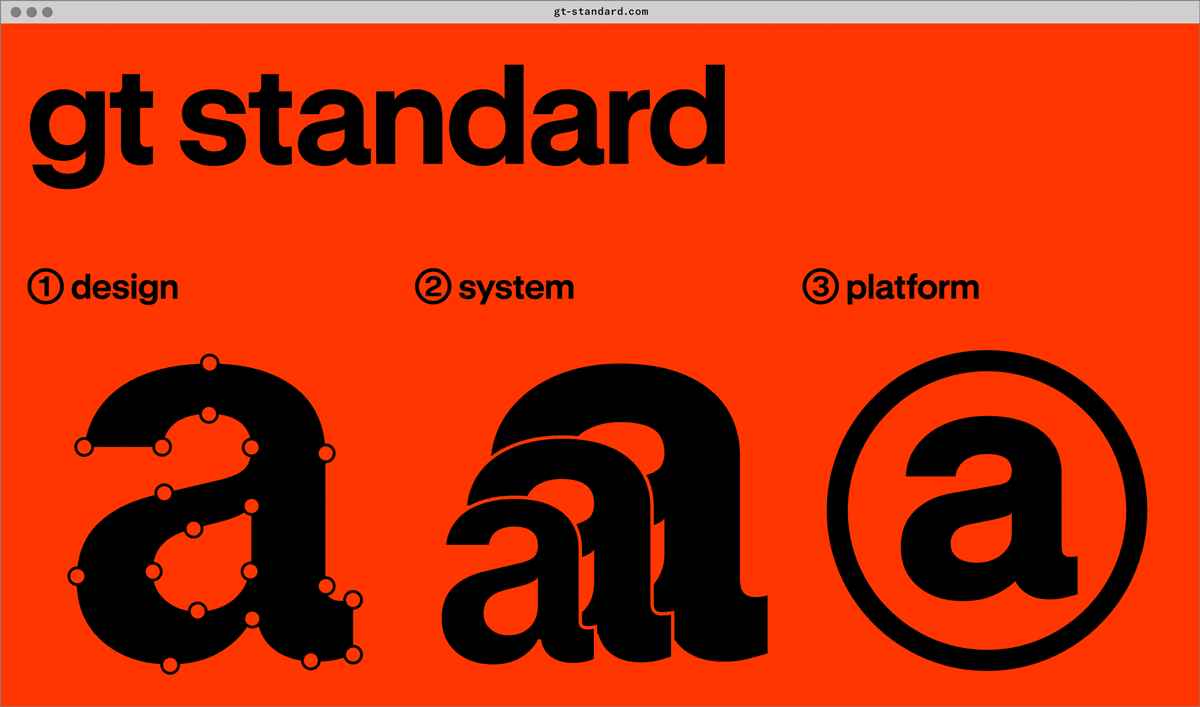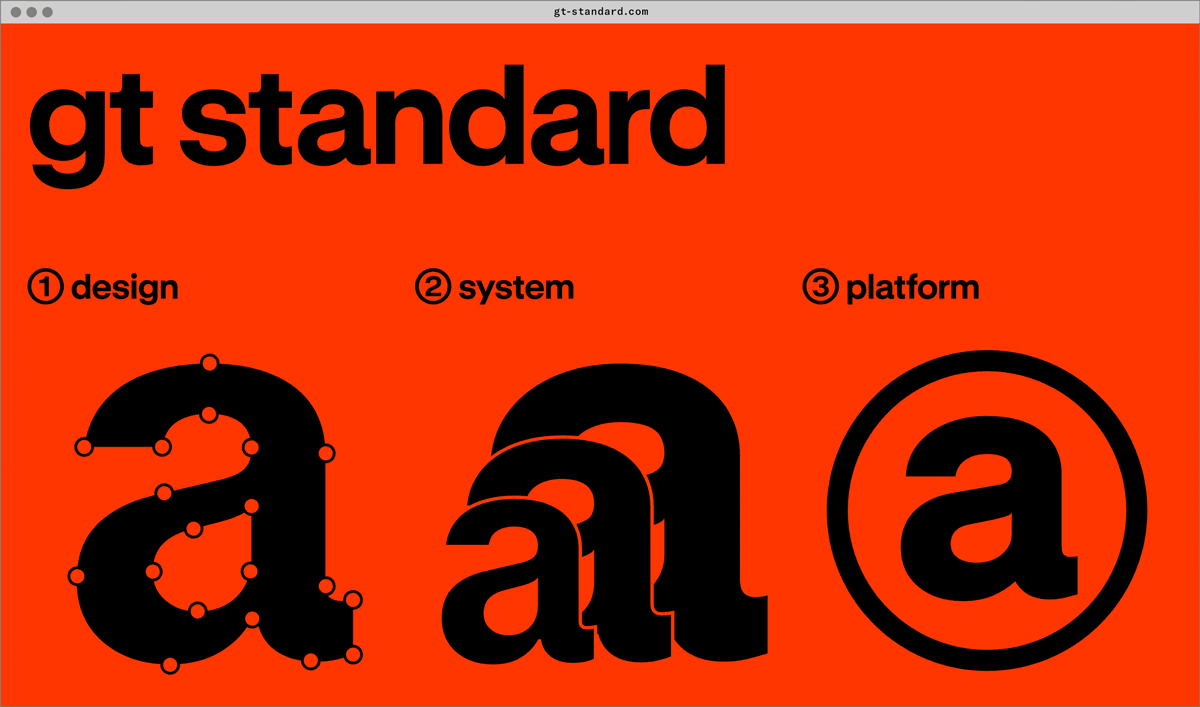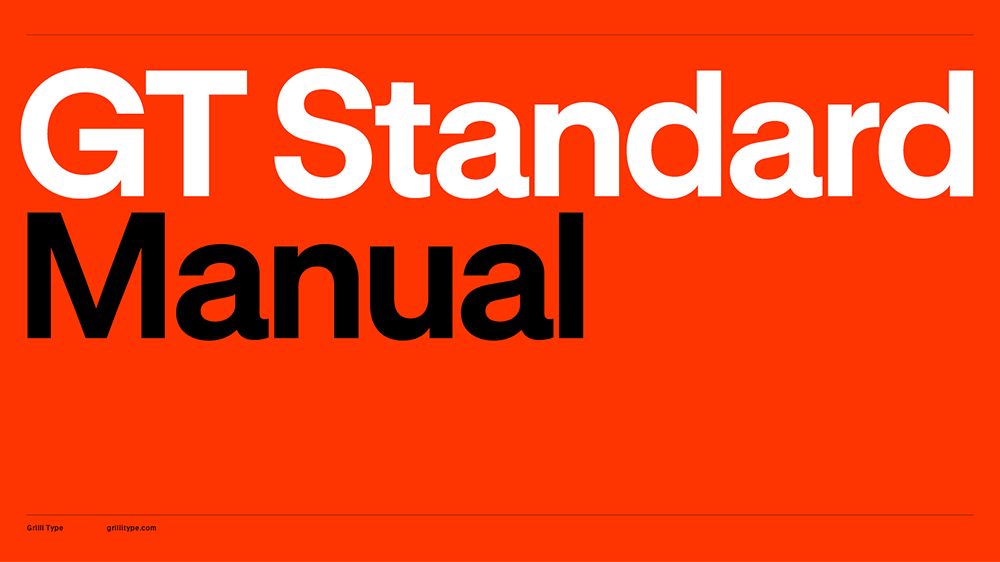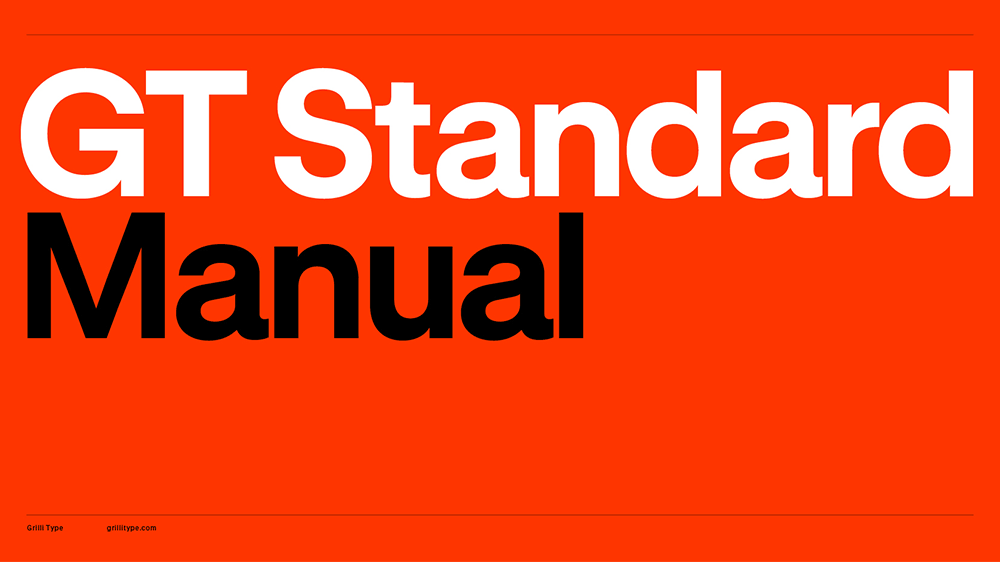GT Standard
Family overview
- Compressed
- S Light Oblique
- M Light Oblique
- L Light Oblique
- S Regular Oblique
- M Regular Oblique
- L Regular Oblique
- S Medium Oblique
- M Medium Oblique
- L Medium Oblique
- S Semibold Oblique
- M Semibold Oblique
- L Semibold Oblique
- S Bold Oblique
- M Bold Oblique
- L Bold Oblique
- S Heavy Oblique
- M Heavy Oblique
- L Heavy Oblique
- S Black Oblique
- M Black Oblique
- L Black Oblique
- Condensed
- S Light Oblique
- M Light Oblique
- L Light Oblique
- S Regular Oblique
- M Regular Oblique
- L Regular Oblique
- S Medium Oblique
- M Medium Oblique
- L Medium Oblique
- S Semibold Oblique
- M Semibold Oblique
- L Semibold Oblique
- S Bold Oblique
- M Bold Oblique
- L Bold Oblique
- S Heavy Oblique
- M Heavy Oblique
- L Heavy Oblique
- S Black Oblique
- M Black Oblique
- L Black Oblique
- Narrow
- S Light Oblique
- M Light Oblique
- L Light Oblique
- S Regular Oblique
- M Regular Oblique
- L Regular Oblique
- S Medium Oblique
- M Medium Oblique
- L Medium Oblique
- S Semibold Oblique
- M Semibold Oblique
- L Semibold Oblique
- S Bold Oblique
- M Bold Oblique
- L Bold Oblique
- S Heavy Oblique
- M Heavy Oblique
- L Heavy Oblique
- S Black Oblique
- M Black Oblique
- L Black Oblique
- Standard
- S Light Oblique
- M Light Oblique
- L Light Oblique
- S Regular Oblique
- M Regular Oblique
- L Regular Oblique
- S Medium Oblique
- M Medium Oblique
- L Medium Oblique
- S Semibold Oblique
- M Semibold Oblique
- L Semibold Oblique
- S Bold Oblique
- M Bold Oblique
- L Bold Oblique
- S Heavy Oblique
- M Heavy Oblique
- L Heavy Oblique
- S Black Oblique
- M Black Oblique
- L Black Oblique
- Extended
- S Light Oblique
- M Light Oblique
- L Light Oblique
- S Regular Oblique
- M Regular Oblique
- L Regular Oblique
- S Medium Oblique
- M Medium Oblique
- L Medium Oblique
- S Semibold Oblique
- M Semibold Oblique
- L Semibold Oblique
- S Bold Oblique
- M Bold Oblique
- L Bold Oblique
- S Heavy Oblique
- M Heavy Oblique
- L Heavy Oblique
- S Black Oblique
- M Black Oblique
- L Black Oblique
- Expanded
- Mono Compressed
- Light Oblique
- Regular Oblique
- Medium Oblique
- Semibold Oblique
- Bold Oblique
- Heavy Oblique
- Black Oblique
- Mono Condensed
- Light Oblique
- Regular Oblique
- Medium Oblique
- Semibold Oblique
- Bold Oblique
- Heavy Oblique
- Black Oblique
- Mono Narrow
- Light Oblique
- Regular Oblique
- Medium Oblique
- Semibold Oblique
- Bold Oblique
- Heavy Oblique
- Black Oblique
- Mono Standard
- Light Oblique
- Regular Oblique
- Medium Oblique
- Semibold Oblique
- Bold Oblique
- Heavy Oblique
- Black Oblique
- Mono Extended
- Light Oblique
- Regular Oblique
- Medium Oblique
- Semibold Oblique
- Bold Oblique
- Heavy Oblique
- Black Oblique
- Mono Expanded
Subfamilies
- Standard S LightThe ANSI for eye protection is Z87.1, which gives a specific impact resistance rating to the eyewear. This standard is commonly used for shop glasses, shooting glasses, and many other examples of protective eyewear.
- Standard M LightAlthough ANSI itself does not develop standards, the Institute oversees the development and use of standards by accrediting the procedures of standards developing organizations.
- Standard L LightANSI accredits standards that are developed by representatives of other standards organizations, government agencies, consumer groups, companies, and others.
- Standard S Light ObliqueMicrosoft Word DOC. Due to the market dominance of Word, it is supported by all office applications that intend to compete with it, typically by reverse engineering the undocumented file format.
- Standard M Light ObliqueANSI's market-driven, decentralized approach has been criticized in comparison with more planned and organized international approaches to standardization.
- Standard L Light ObliqueNot all technical standards are created equal. In the development of a technical standard, private standards adopt a non-consensus process in comparison to voluntary consensus standards.
- Standard S RegularAlthough ANSI itself does not develop standards, the Institute oversees the development and use of standards by accrediting the procedures of standards developing organizations.
- Standard M RegularTechnical standards may exist as closed or controlled documents that contain trade secrets or classified information
- Standard L RegularUse of programming languages R and Python in science and engineering disciplines, other than computer science, where automated analysis of data is required, while remaining simple enough for a non-professional.
- Standard S Regular ObliqueTechnical standards are defined as voluntary consensus standards, which are standards developed or adopted by voluntary consensus standards bodies, domestic (national), regional and international.
- Standard M Regular ObliqueAccording to Adam Stanton, the first permanent secretary and head of staff in 1919, AESC started as an ambitious program and little else. Staff for the first year consisted of one executive, Clifford B. LePage, who was on loan from a founding member, ASME.
- Standard L Regular ObliqueUse of programming languages R and Python in science and engineering disciplines, other than computer science, where automated analysis of data is required, while remaining simple enough for a non-professional.
- Standard S MediumWhen a geographically defined community must solve a community-wide coordination problem, it can adopt an existing standard or produce a new one.
- Standard M MediumThe ANSI for eye protection is Z87.1, which gives a specific impact resistance rating to the eyewear. This standard is commonly used for shop glasses, shooting glasses, and many other examples of protective eyewear.
- Standard L MediumProgramming languages that have multiple implementations such as PHP tend to also have a de facto standard. In PHP's case the de facto standard is the binaries available from php.net, rather than the Phalanger implementation.
- Standard S Medium ObliqueA technical standard may be developed privately or unilaterally, for example by a corporation, regulatory body, military, etc. Standards can also be developed by groups such as trade unions and trade associations.
- Standard M Medium ObliqueTechnical standards are defined as industry standards, also referred to as private standards, which are standards developed in the private sector but not in the full consensus process, typically requiring a financial contribution.
- Standard L Medium ObliqueStandards often get reviewed, revised and updated on a regular basis. It is critical that the most current version of a published standard be used or referenced.
- Standard S SemiboldA standard specification is an explicit set of requirements for an item, material, component, system or service. It is often used to formalize the technical aspects of a procurement agreement or contract.
- Standard M SemiboldThe IBM Personal Computer: by one year after its 1981 release, John Dvorak described the PC as rapidly becoming a de facto standard microcomputer. With the MS-DOS and Microsoft Windows operating systems, it gained a large share of the personal computer market.
- Standard L SemiboldThere are many different standards in many fields of daily life. Standards are important so that correct comparisons can be produced.
- Standard S Semibold ObliqueFor example, a physical property of a material is often affected by the precise method of testing: any reference to the property should therefore reference the test method used.
- Standard M Semibold ObliqueMIDI connection (using DIN connector or Phone connector), electrical and protocol standard for connecting musical instruments, synthesizers, drum machines, sequencers, and some audio equipment.
- Standard L Semibold ObliqueIt is usually a formal document that establishes uniform engineering or technical criteria, methods, processes, and practices.
- Standard S BoldA standard is a basis for comparison. Standards are made either by many people that agree on something, or if some organisation makes it so.
- Standard M BoldTechnical standards are defined as Government standards, which are standards developed by the government for its own uses.
- Standard L BoldA standard test method describes a definitive procedure that produces a test result. It may involve making a careful personal observation or conducting a highly technical measurement.
- Standard S Bold ObliqueStandard units, in physics and applied mathematics, are commonly accepted measurements of physical quantities.
- Standard M Bold ObliqueFor example, a physical property of a material is often affected by the precise method of testing: any reference to the property should therefore reference the test method used.
- Standard L Bold ObliqueAccording to Adam Stanton, the first permanent secretary and head of staff in 1919, AESC started as an ambitious program and little else. Staff for the first year consisted of one executive, Clifford B. LePage, who was on loan from a founding member, ASME.
- Standard S HeavyThe ANSI/APSP (Association of Pool & Spa Professionals) standards used for pools, spas, hot tubs, barriers, and suction entrapment avoidance.
- Standard M HeavyCommunication protocols such as Morse code and USB are standards that allow different machines and people to communicate.
- Standard L HeavyStandards organizations often have more diverse input and usually develop voluntary standards: these might become mandatory if adopted by a government (i.e., through legislation), business contract, etc.
- Standard S Heavy ObliqueThe MP3 audio format started as an alternative to WAV for internet music distribution, then replaced it. It is now supported by the vast majority of music players, audio transport, audio storage, and non-commercial media.
- Standard M Heavy ObliqueAutoCAD DXF, an ASCII format for import and export of CAD drawings and fragments in the 1980s and 1990s. In the 2000s, XML based standards emerged as de facto standards.
- Standard L Heavy ObliqueIn social sciences, including economics, a standard is useful if it is a solution to a coordination problem: it emerges from situations in which all parties realize mutual gains, but only by making mutually consistent decisions.
- Standard S BlackPCI Express electrical and mechanical interface, and interconnect protocol used in computers, servers, and industrial applications.
- Standard M BlackA de facto standard is a custom or convention that is commonly used even though its use is not required. De facto is a Latin phrase meaning in practice but not necessarily ordained by law, or in practice or actuality, but not officially established.
- Standard L BlackProgramming languages that have multiple implementations such as PHP tend to also have a de facto standard. In PHP's case the de facto standard is the binaries available from php.net, rather than the Phalanger implementation.
- Standard S Black ObliqueCommunication protocols such as Morse code and USB are standards that allow different machines and people to communicate.
- Standard M Black ObliqueTechnical standards are defined as Government standards, which are standards developed by the government for its own uses.
- Standard L Black ObliqueThe ANSI/APSP (Association of Pool & Spa Professionals) standards used for pools, spas, hot tubs, barriers, and suction entrapment avoidance.
- Settings
Typeface information
GT Standard is a contemporary response to the modernist pursuit of standardization. It’s rooted in the principles of Swiss Style and expands on this legacy to meet the needs of today’s visual landscape. The typeface is systematic yet expressive, built for clarity, adaptability, and precision across every scale and medium.
Typeface features
OpenType features enable smart typography. You can use these features in most Desktop applications, on the web, and in your mobile apps. Each typeface contains different features. Below are the most important features included in GT Standard’s fonts:
- SS01
- Alternate a
Regards
- SS02
- Alternate g
Engaging
- SS03
- Alternate y
Energy
- SS04
- Alternate Q
Quality
- SS06
- Rectangular Dots
Minimalism
- SS07
- Account Spoofing
Informal
Typeface Minisite


- Visit the GT Standard minisite to discover more about the typeface family’s history and design concept.

